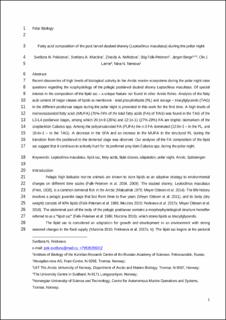| dc.contributor.author | Pekkoeva, Svetlana N. | |
| dc.contributor.author | Murzina, Svetlana A. | |
| dc.contributor.author | Nefedova, Zinaida A. | |
| dc.contributor.author | Falk-Pedersen, Stig | |
| dc.contributor.author | Berge, Jørgen | |
| dc.contributor.author | Lønne, Ole Jørgen | |
| dc.contributor.author | Nemova, Nina N. | |
| dc.date.accessioned | 2021-03-01T12:35:41Z | |
| dc.date.available | 2021-03-01T12:35:41Z | |
| dc.date.created | 2020-08-05T12:52:03Z | |
| dc.date.issued | 2020 | |
| dc.identifier.citation | Polar Biology. 2020, 43 (6), 657-664. | en_US |
| dc.identifier.issn | 0722-4060 | |
| dc.identifier.uri | https://hdl.handle.net/11250/2730931 | |
| dc.description.abstract | Recent discoveries of high levels of biological activity in the Arctic marine ecosystems during the polar night raise questions regarding the ecophysiology of the pelagic postlarval daubed shanny Leptoclinus maculatus. Of special interest is the composition of the lipid sac—a unique feature not found in other Arctic fishes. Analysis of the fatty acid content of major classes of lipids as membrane—total phospholipids (PL) and storage—triacylglycerols (TAG) in the different postlarvae stages during the polar night is presented in this work for the first time. A high level of monounsaturated fatty acids (MUFAs) (71–74% of the total fatty acids (FA) of TAG) was found in the TAG of the L3-L4* postlarvae stages, among which 20:1(n-9) (28%) and 22:1(n-11) (27–29%) FAs are trophic biomarkers of the zooplankton Calanus spp. Among the polyunsaturated FA (PUFA), the FAs of (n-3) class were dominated (22:6(n-3)—in the PL, and 18:4(n-3)—in the TAG). A decrease in the content of the saturated FA (SFA) and an increase in the MUFA in the structural PL during the transition from the postlarval to the demersal stage were observed. Our analyses of the FA composition of the lipid sac suggest that the fish continues to actively hunt for its preferred prey item Calanus spp. during the polar night. | en_US |
| dc.language.iso | eng | en_US |
| dc.publisher | Springer | en_US |
| dc.title | Fatty acid composition of the postlarval daubed shanny (Leptoclinus maculatus) during the polar night | en_US |
| dc.type | Peer reviewed | en_US |
| dc.type | Journal article | en_US |
| dc.description.version | acceptedVersion | en_US |
| dc.source.pagenumber | 657-664 | en_US |
| dc.source.volume | 43 | en_US |
| dc.source.journal | Polar Biology | en_US |
| dc.source.issue | 6 | en_US |
| dc.identifier.doi | 10.1007/s00300-020-02669-4 | |
| dc.identifier.cristin | 1821783 | |
| dc.relation.project | Norges forskningsråd: ES504895 | en_US |
| dc.relation.project | Norges forskningsråd: 244319 | en_US |
| dc.relation.project | Norges forskningsråd: 245923 | en_US |
| dc.description.localcode | This is a post-peer-review, pre-copyedit version of an article. Locked until 23/4-2021 due to copyright restrictions. The final authenticated version is available online at: http://dx.doi.org/10.1007/s00300-020-02669-4 | en_US |
| cristin.ispublished | true | |
| cristin.fulltext | postprint | |
| cristin.qualitycode | 1 | |
